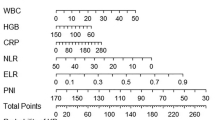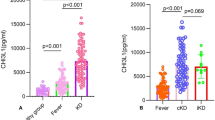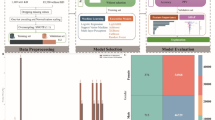Abstract
Background:
As Kawasaki disease (KD) shares many clinical features with other more common febrile illnesses and misdiagnosis, leading to a delay in treatment, increases the risk of coronary artery damage, a diagnostic test for KD is urgently needed. We sought to develop a panel of biomarkers that could distinguish between acute KD patients and febrile controls (FC) with sufficient accuracy to be clinically useful.
Methods:
Plasma samples were collected from three independent cohorts of FC and acute KD patients who met the American Heart Association definition for KD and presented within the first 10 d of fever. The levels of 88 biomarkers associated with inflammation were assessed by Luminex bead technology. Unsupervised clustering followed by supervised clustering using a Random Forest model was used to find a panel of candidate biomarkers.
Results:
A panel of biomarkers commonly available in the hospital laboratory (absolute neutrophil count, erythrocyte sedimentation rate, alanine aminotransferase, γ-glutamyl transferase, concentrations of α-1-antitrypsin, C-reactive protein, and fibrinogen, and platelet count) accurately diagnosed 81–96% of KD patients in a series of three independent cohorts.
Conclusion:
After prospective validation, this eight-biomarker panel may improve the recognition of KD.
Similar content being viewed by others
Log in or create a free account to read this content
Gain free access to this article, as well as selected content from this journal and more on nature.com
or
References
Taubert KA, Rowley AH, Shulman ST. Nationwide survey of Kawasaki disease and acute rheumatic fever. J Pediatr 1991;119:279–82.
Newburger JW, Takahashi M, Gerber MA, et al.; Committee on Rheumatic Fever, Endocarditis and Kawasaki Disease; Council on Cardiovascular Disease in the Young; American Heart Association; American Academy of Pediatrics. Diagnosis, treatment, and long-term management of Kawasaki disease: a statement for health professionals from the Committee on Rheumatic Fever, Endocarditis and Kawasaki Disease, Council on Cardiovascular Disease in the Young, American Heart Association. Circulation 2004;110:2747–71.
Wilder MS, Palinkas LA, Kao AS, Bastian JF, Turner CL, Burns JC. Delayed diagnosis by physicians contributes to the development of coronary artery aneurysms in children with Kawasaki syndrome. Pediatr Infect Dis J 2007;26:256–60.
Tremoulet AH, Best BM, Song S, et al. Resistance to intravenous immunoglobulin in children with Kawasaki disease. J Pediatr 2008;153:117–21.
Tsuchiya K, Imada Y, Aso S, Sonobe T. [Diagnosis of incomplete Kawasaki disease]. Nihon Rinsho 2008;66:321–5.
Rowley AH. Incomplete (atypical) Kawasaki disease. Pediatr Infect Dis J 2002;21:563–5.
Sonobe T, Kiyosawa N, Tsuchiya K, et al. Prevalence of coronary artery abnormality in incomplete Kawasaki disease. Pediatr Int 2007;49:421–6.
Anderson MS, Todd JK, Glodé MP. Delayed diagnosis of Kawasaki syndrome: an analysis of the problem. Pediatrics 2005;115:e428–33.
Newburger JW, Takahashi M, Beiser AS, et al. A single intravenous infusion of gamma globulin as compared with four infusions in the treatment of acute Kawasaki syndrome. N Engl J Med 1991;324:1633–9.
Takeshita S, Kawamura Y, Takabayashi H, Yoshida N, Nonoyama S. Imbalance in the production between vascular endothelial growth factor and endostatin in Kawasaki disease. Clin Exp Immunol 2005;139:575–9.
Dahdah N, Siles A, Fournier A, et al. Natriuretic peptide as an adjunctive diagnostic test in the acute phase of Kawasaki disease. Pediatr Cardiol 2009;30:810–7.
Yu HR, Kuo HC, Sheen JM, et al. A unique plasma proteomic profiling with imbalanced fibrinogen cascade in patients with Kawasaki disease. Pediatr Allergy Immunol 2009;20:699–707.
Ishiguro A, Ishikita T, Shimbo T, et al. Elevation of serum thrombopoietin precedes thrombocytosis in Kawasaki disease. Thromb Haemost 1998;79:1096–100.
Sakata K, Hamaoka K, Ozawa S, et al. Matrix metalloproteinase-9 in vascular lesions and endothelial regulation in Kawasaki disease. Circ J 2010;74:1670–5.
Kuo HC, Wang CL, Liang CD, et al. Association of lower eosinophil-related T helper 2 (Th2) cytokines with coronary artery lesions in Kawasaki disease. Pediatr Allergy Immunol 2009;20:266–72.
Barone SR, Pontrelli LR, Krilov LR. The differentiation of classic Kawasaki disease, atypical Kawasaki disease, and acute adenoviral infection: use of clinical features and a rapid direct fluorescent antigen test. Arch Pediatr Adolesc Med 2000;154:453–6.
Sato YZ, Molkara DP, Daniels LB, et al. Cardiovascular biomarkers in acute Kawasaki disease. Int J Cardiol 2013;164:58–63.
Bratincsak A, Reddy VD, Purohit PJ, et al. Coronary artery dilation in acute Kawasaki disease and acute illnesses associated with Fever. Pediatr Infect Dis J 2012;31:924–6.
Muniz JC, Dummer K, Gauvreau K, Colan SD, Fulton DR, Newburger JW. Coronary artery dimensions in febrile children without Kawasaki disease. Circ Cardiovasc Imaging 2013;6:239–44.
Gunn L, Nechyba C. The Harriet Lane Handbook. 16th edn. Mosby: Philadelphia, 2002.
Tremoulet AH, Jain S, Chandrasekar D, Sun X, Sato Y, Burns JC. Evolution of laboratory values in patients with Kawasaki disease. Pediatr Infect Dis J 2011;30:1022–6.
Ohno-Machado L, Bafna V, Boxwala AA, et al.; iDASH team. iDASH: integrating data for analysis, anonymization, and sharing. J Am Med Inform Assoc 2012;19:196–201.
Breiman L. Random forests. MLear 2001;45:5–32.
Acknowledgements
The authors wish to thank Nicki Daniels and the San Diego KD pediatric parents group who raised money to help fund this research. Members of the Pediatric Emergency Medicine Kawasaki Disease Research Group included Jim R. Harley, MD, MPH, Simon J. Lucio, MD, Seema Shah, MD, and Stacey Ulrich, MD.
Author information
Authors and Affiliations
Consortia
Corresponding author
Supplementary information
Supplementary Table S1
(XLS 484 kb)
Supplementary Table S2
(DOC 39 kb)
Rights and permissions
About this article
Cite this article
Tremoulet, A., Dutkowski, J., Sato, Y. et al. Novel data-mining approach identifies biomarkers for diagnosis of Kawasaki disease. Pediatr Res 78, 547–553 (2015). https://doi.org/10.1038/pr.2015.137
Received:
Accepted:
Published:
Issue date:
DOI: https://doi.org/10.1038/pr.2015.137
This article is cited by
-
A machine learning model for distinguishing Kawasaki disease from sepsis
Scientific Reports (2023)
-
Risk factors and implications of progressive coronary dilatation in children with Kawasaki disease
BMC Pediatrics (2017)



